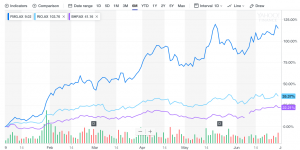The winner in 2018-19 and so far in 2019 is …iron ore…. with a gain of 82% over 2018-19. The June 28 Metal Bulletin price was $US118.47 a tonne, up from June 2018’s average of $US65.20 and the end of December 2018 price of $US72.73.
And the biggest winner among the miners is Fortescue Metals – its shares surged more than 105% in 2018-19, far ahead of Rio’s very sold 24.3% and BHP’s equally solid 21.4%.
Iron ore’s 64% gain so far this year (or $US46 a tonne) was due to the January 25 dam wall disaster at the Brumadinho mine in Vale’s southeastern mining complex in Brazil.
That triggered the closure of a number of other mines in the region using wet processing (the core process at Brumadinho mine and at the Samarco operation co-owned with BHP where a similar disaster occurred in 2015).
All up between 40 and 90 million tonnes of production capacity has been idled at different times, cutting Vale exports into the global market, especially China.
That, in turn, came as Chinese mills were enjoying strong profits from high prices in the Chinese domestic market. The shortages saw the mills run down their stocks of iron ore to keep their mills running at higher utilisation levels (which means high-profit margins).
The desperation for high-quality ore saw the mills boost their purchases of lower quality ore – such as the 58% Fe product produced by Fortescue which in turn saw the gap between 58% and 62% Fe ore narrow and spectacular profits for Fortescue.
But for how long? The Chinese mills are seeing profit margins crimped by weakening internal demand, steel exports are flat and global supplies will improve in the second half of the year, even after Rio Tinto’s surprise problems in the Pilbara which will trim exports in July and August.
Vale’s 30 million tonnes a year Bructu mine of Vale – its largest in the southeastern group of mines – is now back in operation (it’s wet and dry processing facilities are back in full swing) and 10 million or so extra tonnes will be on the market this half.
Despite that Vale is still looking for a 50 to 60 million tonne cut to sales this year
2019’s surge in iron pre prices has boosted the Australian federal budget to the point where a small surplus will be reported in August for the 2018-19 financial year – a year earlier than expected, with the added boost of lower than expected spending and bracket creep on tax rates.
Corporate tax income will be higher for big iron ore groups, and LNG exporters, but the rest will be reporting weaker returns – even the big four banks.
The Metal Bulletin 62% Fe price only rose $US1.70 a tonne over the week – from $US116.77 the Friday before to June 28’s $US118.47,
But the gain over June was a massive 18% – from $US101.60 at the end of May (the price fell 7% in the final week of that month) to Friday’s end of $US118.47.
Adding to the pressures on global supplies from the Vale dam disaster were fires at two Rio export terminals this year and the impact of Cyclone Veronica on the Pilbara ports of BHP, Rio, and Fortescue.
As well Rio is constraining exports of high-grade ore – lump and fines – in at least July and August because of production and operational problems at its Brockman hub in the Pilbara. The problems at Rio has forced it to slice its 2019 production by up to 30 million tonnes.
2018’s shipments totaled 338 million tonnes and the current forecast is a range of 320 million to 330 million tonnes. The surge in prices will save Rio from the embarrassment of a big hit to revenues, but the forgone impact could be over $US3 billion at current prices.
For the big iron ore miners, June and 2019 has been something of a golden time so far as the share prices are concerned.
BHP shares added 21.4% over 2018-19 to Friday’s close of $41.16 (last week saw the shares hit an 8 year high late in the week). Year to date the shares are up more than 20%, and 9.9% in the final quarter of the financial year. But the June quarter saw a very solid 9% gain.
It was a similar story for Rio Tinto. Despite all the problems, the shares rose 24.3% in 2018-19 (closing at $US103.76 on June 28) but so far in 2019, the gain is a much stronger 32.2%.
The June quarter saw a 6% gain and a 3.4% rise in the month of June. Rio hit an all-time high of $US107.99 in late June.
But the real star has been Fortescue Metals – its shares jumped 10.5% for the year to June 28 (closing at $9.02) – thanks to a 115% plus a surge in the first six months of 2019.
Bumper half for Fortescue shares

The June quarter saw a near 27% jump and a 12% gain in June alone. No wonder the company aid a special 60 cents a share dividend before the May 18 election, it is swimming in cash as the margin between the 58% Fe ore that Fortescue’s main product type and the 62% Fe product shipped by BHP and Rio.
The margin is now down to less than 8% instead of more than 20% in 2018.







